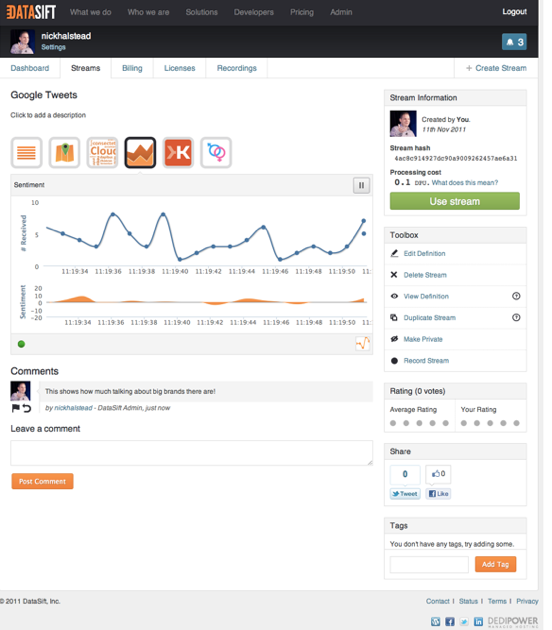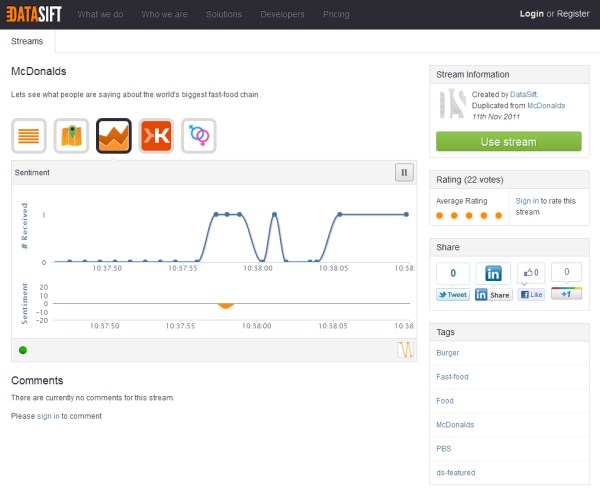Social CRM
Social Intelligence
DataSift Offers Analytic Insight into Your Social Media Presence

The rise of social media marketing has organizations wondering how they can get real metrics out of their social media presence to determine the overall effectiveness of social strategies. We talked to DataSift CEO Rob Bailey and founder Nick Halstead to find out how they can fill this crucial role by providing across-the-board analytics and serving as the backbone to various social CRM and other applications.

WEBSITE: www.datasift.com
FOUNDED: 2010
LOCATION: London, UK/San Francisco, CA
SOLUTIONS: Datasift Big Data Analytics
What was the inspiration behind Datasift? What were the business needs you saw that weren’t being addressed?
Rob Bailey: We started out as a company called Tweet Me, which was basically a news curating service on top of Twitter. We found we built such an amazing infrastructure that other companies wanted to use our infrastructure. So we had more and more companies approaching us about building an infrastructure, and we thought “My gosh. We have this big opportunity in helping companies with their infrastructures, rather than just using it for ourselves.” So that was our opportunity–that’s when it really became clear the bigger opportunity was in being a data management platform for social data.
One of the biggest trends we’re seeing in business software in terms of people who are starting out in bringing new product is business intelligence and big data in particular. How did you get the inspiration to focus solely on mining data from social media networks?
RB: We built an amazing platform that can operate with any type of structured or unstructured data, but we focus first on social data because it’s very much top of mind for companies. So that’s why.
It seems like there are a lot of different industries that this sort of technology can be extended to. Have you noticed any particular trends in companies or organizations that are really the most interested in what you’re doing and becoming potential clients? Has that affected the way you’re doing your business so far
RB: We’re finding there’s a wide range of demand for our services across a range of verticals. So we’re just trying to prioritize. I think the key message is really that social is really going mainstream. I think how we’re just finding every industry needs to figure out how they’re going to use social.
Give an example of a way in which social media insights can be used effectively by a client company or organization.
RB: We have lots of different types of data–Twitter, Facebook, Amazon, Trip Advisor. The list goes on and on. We’ve been absolutely blown away at the myriad different uses of social data. Some of them include brand monitoring, and the analysis and effectiveness of social ad campaigns; the analysis of campaigns from other medium, like TV commercials, go viral. These organizations use it to identify emerging, breaking news stories and tracking their diffusion to social. A business intelligence company is including social data in their platforms. And financial services organizations use it to identify potential trading opportunities.
Is this a crowded/competitive segment? Are there a lot of other developers working on analytics purely for social media data?
RB: We are focused first on social media, but we’re already expanding out of the news in other types of data over the coming year.
Nick Halstead: More specifically unstructured data. This platform is very much designed to deal with the growing amount of unstructured data. You know, 50 percent of all data in most businesses is unstructured. So we are moving into aggregating data on behalf of customers that sift inside that potentially siloed areas. A good example is something like a large organization using some kind of instant messenger work for the employees. Why not use this same technology to process that data as you would the public data?
What’s your biggest challenge technology-wise or business-wise, and how are you addressing it?
RB: I think that our biggest challenge is that the social data space is exploding, and we’ve just been flooded with interest from customers. Our business is growing incredibly quickly.
But that said, I think it’s really important for us always provide a very high level of service, plus everything we do to our customers. I think probably our biggest challenge and what keeps Nick and I up at night is wondering how do we manage this explosive growth of our company in such a way that we continue to provide awesome service to our customers?
In regards to social media marketing the most common questions is “what’s the ROI on it,” or “how do I figure out the cost-benefit ratio of my social media presence?” Can Datasift address those questions, or are they besides the point?
NH: My point of view has been the last few years you could say there hasn’t been much return on that investment. One of the things I always argue is, let’s give an example of something like this brand monitoring. A lot of the companies that work in that space use social media analysis to basically get a rough guide to the movement of traffic about your brand. Then they look at the sentiment toward the brand or campaign. But actually, all of that is pointless as it doesn’t let you know who those people [on social media] are and where they live, and some kind of demographics about them.
That’s why we–about four or five weeks ago–launched a demographic service so that you can correlate between the sentiment and the whole range of demographics – so age range, gender, location all the way down to U.S. city. And then with that kind of data you can actually say, “Well, our message is being heard by the customers that we actually want to talk to.” Without that data, you’re pretty much flying blind. You’re basically saying, “The whole of the internet had this reaction to our marketing, but we know nothing more than that.” It’d be the equivalent of you going out and holding a clipboard out on the street, asking people questions and literally writing down someone’s name and saying “do you like this or not?” Then they say, “yes.” And then asking them no further questions, which would be ridiculous, and the marketing department would sack you when you got back. All of us are working giving our platform greater ability to give deep answers to these questions. The return on the investment is so much greater because you can actually spot the correlations. We preach very much this whole idea of actionable insights, not pretty graphics.
Where is social media analytics headed in the next five years? What are some of the challenges and opportunities you foresee?
NH: The marketing, I think is fascinating. It’s a very under-served area in that if you imagine how many billions get spent on search engine marketing, the reality is that your optimized content is delivered out into the social wind. Some sites now derive 50 percent of their traffic from social. Why would you not be spending the same numbers of billions in getting the content right?
So we already see a lot of companies who have integrated Datasift, all of them offering analytics around optimizing content in real time. So what we can show to a customer is competitive; let’s think of someone like the publishing business. When you post a new story, we can see all your competitors for that sort of content. We can see the comparison on how well those are being received, or whether the demographics behind them are different, what the sentiment is. We see a lot of other businesses being built on top of this better and better data who are able to then optimize the content. Just like with SEO there’s a whole range of optimizations you can perform in social media. So I think that over the next years, that’s going to be a big growth area for us and for people buying data. We have a number of new data streams coming online soon that are going to create that.
The fates of social media platforms are notoriously fickle. Are you concerned that today’s top platforms might be passe or irrelevant in a few years’ time? Or is that not an issue for the way you’ve built your technology?
NH: That gives us even more reason for why people now are buying from us direct. It’s because we removed that risk of you integrating a platform that’s gone to [inaudible] the licensing from whatever network – be it two years’ time, three years’ time – become big.
We’ve been working with Twitter for over four years, and we already have relationships in most of the networks that are up and coming. It’s our job to make sure that we integrate them. One of the biggest aspects of Datasift is really we do a whole ETL (Extract, Transform, Load) of the data, converting it into a standardized format and making it so that when you use the service, you only have to program once to access all of the different data sets that we include.
We are still very bullish with this consumer-based market. They continue to accelerate their growth faster than we’ve ever seen before. So we have no fears for Twitter at the moment. But there will be other networks that we’ll obviously be interested in. But we also believe social will only be a third of our revenue in a year’s time because the marketplace for unstructured processing is vast.
What excites you the most about Datasift?
NH: I think it’s the fact that the market is going to be, and already is, massive. It’s an underserved market right now.
Rob gave a great example yesterday. He asked me if they made services for companies where they monitor news, a lot of people still stay with Google News Alert. That’s such an unsophisticated tool. When I look at many of the monitoring companies that are powered by Datasift they are also very unsophisticated. We are pushing a whole new agenda, two key agendas. One is you can be a lot more accurate about what data you’re getting. You can capture data. You can get derive actionable insights from it and make that data be integrated into systems you already own. That message is being picked up very rapidly. We’re excited that this is a multi-billion dollar marketplace that we’re going into.







